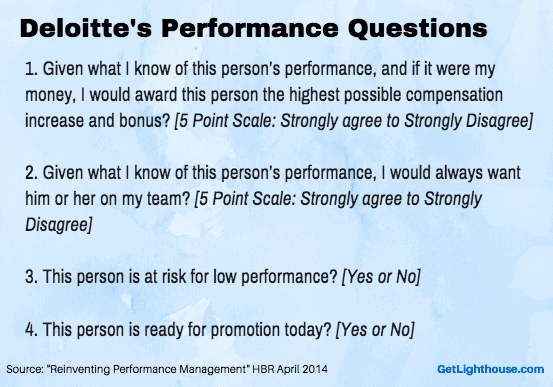Employee performance reviews have taken a lot of heat lately. They're viewed as a dated, wasteful, ineffective process. From HR to managers, to the employees receiving them, they're hated.
Some of the reasons for this hatred include:
- Time Consuming: It takes a ton of time for a manager to write a review of 12 months of work for each of their staff, and even more for HR leaders to organize and track it all.
- Poor Memory: Reviews often don't represent everyone's work; it's instead based on a handful of strong memories and what happened in the last few weeks.
- Shock & Surprise: Employees are often blind-sided by feedback they're hearing for the first time that now directly impacts their compensation and promotion prospects for the next year.
- Overwhelming: When you're given a list of 20 things to change or improve, it's hard to take in any of it, let alone change.
- Cultural Poison: Stack rankings as part of employee performance reviews has been shown repeatedly to hinder team collaboration and be destructive to morale.

When an activity has this many problems (and many more), it's not surprising that some are calling for completely doing away with them. But is that the right move?
As the old saying goes, "Don't throw the baby out with the bathwater." Instead, it's worth looking at what needs to change, while also remembering the good reasons they were created in the first place.

The Case for Keeping Employee Performance Reviews
Employee performance reviews aren't all bad. There were good intentions behind creating them, and there's still some good in them today. The key is to recognize the problems and look to fix them, while still tapping into the benefits and purpose of reviews.
So before you venture into the brave new world of abandoning reviews entirely, consider what reviews bring to the table, and how you can address some of review's biggest problems.

1) Reflecting at a set time is a good thing.
This is one of the simplest, but most important factors of reviews. By having a set time for reviews, you solve a few key problems:
Problem #1: When do people get compensation changes?
Without reviews, it becomes a big question: How do you decide when people get raises and promotions? If you do them ad hoc, it can put your managers in a bind where people ask at times that are inconvenient (like budget isn't clear at the time) or multiple times in a year.
On the other side, it can also affect turnover. A leader that isn't given a set time to re-evaluate people's compensation can easily procrastinate and not give any raises to deserving staff. Eventually, that staff will seek a raise by taking a job somewhere else.
Problem #2: How do I know how I'm really doing?
Without a review, it's hard to judge performance. While regular feedback (more on that later) provides many benefits, it's also helpful to zoom out and take a cumulative look at someone's performance.
By having a structured time to sit down and talk about an employee's longer term performance, managers can make it more clear whether someone is trending up, down, or steady.
Without having a set time to look back and reflect, it can be easy to miss when an underperformer isn't meeting standards for a long period of time. It can also lead to a top employee's performance going unrecognized for too long.
Problem #3: When do people get promoted?
The easy answer would seem to be "when they're ready," but that creates many problems. When there is a set date, your employees know when they'll be evaluated. It gives them something to strive for.
When there is no set time to consider if they're ready, it's very easy for a manager to say, "Not now. Let's talk when things settle down." While it may be innocent to push back a discussion, putting it off can frustrate and stifle a top performer, or even someone who just wants to know if they're still on track in a year or two.
This also creates a problem at the macro level for your business. By having everyone evaluated at the same time, you can plan budgets, and changes to the org chart. If you get rid of employee performance reviews, this becomes an unstructured, ad hoc event that can either constantly be happening, or constantly be put off. Neither is a good result.
Employee performance reviews are often imperfect at addressing these problems. However, having any discussion with your employees reflecting on the long term views of the past and future is better than them never happening at all. Too often, best intentions fail to happen without a deadline.

2) Use one on ones to complement not replace reviews
Today's hot HR trend is to replace employee performance reviews with one on ones. Companies like Deloitte, Adobe, Accenture, and GE have all made big press pushes to proudly declare the change. This is because doing so has had a major impact:
- GE was able to "drive a fivefold productivity increase in the past 12 months” and sourced a number of very profitable ideas for improvements inside and out of the organization from one on one conversations.
- Adobe saw a "saw a 30 percent reduction in voluntary turnover."
- Deloitte reported that their employees, "are ecstatic around this process.”
While we're big fans of more companies having one on ones, it doesn't have to be an either/or decision. You can have both. They can complement each other very well.

You can have one on ones, and keep your reviews.
There are many benefits to your employees having one on ones with their managers. It provides a time to focus on things important to the employee like interpersonal issues, a desire for feedback or coaching, or a discussion about their growth and development.
It has a huge payoff, as former Intel CEO Andy Grove wrote in High Output Management, "90 minutes of your time [in a one on one] can enhance the quality of your subordinate's work for 2 weeks, or for some 80+ hours.”
One on ones make employee performance reviews better.
If you start having one on ones in your company, you can keep your employee performance reviews. In fact, one on ones will significantly improve your reviews:
- Done faster & better: When a manager takes notes in one on ones, they now have a record to look back at when they write reviews. This eliminates the problem of managers remembering only the last few weeks, or wasting time trying to remember something to write.
- No Surprises: If a manager uses their one on ones to give feedback and set expectations for improvement, any critiques in a performance review will be a recap, not the first time they hear something.
- Bridge the review: When you talk about key issues and opportunities in a review, it's easy for that discussion to never happen again until next review. One on ones provide the perfect place to continue to work on these things, leading to real progress to reflect on next review.
As your managers get more comfortable in their one on ones, it can also reduce the strain of the performance review. Rather than trying to cram everything into the review, they can tackle many issues and opportunities before the next review arrives. This turns a major section of your reviews into a nod to an ongoing discussion.
Start one on ones on the right foot.
It's important your managers are given support and coaching to make the most of their one on one meetings. Otherwise, it can feel like another mandated time sink on their schedule. With the right help, they and their team will look forward to them, and it will make your employee performance reviews better.

3) Iterate on your review process, don't throw it away.
Yes, there are problems with many employee performance reviews. However, that doesn't mean you should crumple the whole thing up and throw it away.
Instead, take a look at what's not working and try to address those issues. Here's a few common problems, and how others have addressed them:
1. Get rid of stack rankings, but still evaluate people.
There's signficant evidence that shows stack ranking does a lot more harm than good. It turns teammates against each other, hurts teams loaded with high performers, and puts managers in difficult positions. This video highlights some of the negatives of what happens:
A growing number of companies have moved away from them after seeing how the process hurts morale and retention. While they have gotten rid of the rankings, most have continued to hold reviews. They've just realized that you can evaluate people without trying to force people onto a bell curve.
2. Be mindful of the questions you ask.
We're all biased in ways we don't realize. Researchers Michael Mount, Steven Scullen, and Maynard Goff found that when you ask someone to evaluate another person's skills, the score you give someone is more reflective of the rater, than the actual abilities of the person being rated:
"The study—in which 4,492 managers were rated on certain performance dimensions by two bosses, two peers, and two subordinates—revealed that 62% of the variance in the ratings could be accounted for by individual raters' peculiarities of perception. Actual performance accounted for only 21% of the variance."
Knowing this, Deloitte looked to reinvent the questions they ask around performance. Deloitte found in their experiments, "People may rate other people's skills inconsistently, but they are highly consistent when rating their own feelings and intentions."
Better questions, better results.
Deloitte's discovery led to them developing these simple, direct questions to guide their managers in evaluating their teams:

These simple questions strike at the heart of what most evaluations are trying to find out: Is this person performing well? Do they deserve a raise or promotion? Are there any major issues that must be improved?
This simplicity saves Deloitte managers time, while still meeting the needs for reviewing performance. Don't over-complicate things.
Google measures their managers.
Google has similarly done a great deal of research, and experimenting, on the questions they ask in their reviews.
First, their People Analytics team uncovered the key behaviors for effective, motivating managers. Then, they turned those behaviors into questions to ask their teams to evaluate their managers. This had great results for them, which Laszlo Bock wrote about in detail in his book, Work Rules. You can read more on the story here.
If you don't feel like your employee performance reviews are working today, try changing the questions you ask. Try removing a few, simplifying them, or being more direct about what you want to learn. You may be surprised how it can lead to better results, and less resistance from those writing reviews.
3. Get feedback and ideas from your people.
One of the common threads for the trailblazing companies changing employee performance reviews is how they listen to their people. By measuring the impact and engaging their employees in the process, they've gotten better results.
Part of the resistance many give to doing reviews is because it's dictated to them. No one likes being forced to do something.
By involving them in the process, and listening to their feedback, they will feel some ownership. A few small changes based on their feedback will improve the review, and help get their buy in. This can then save you a bunch of time and effort spent badgering managers to complete them.

Laszlo Bock, VP of People at Google, has successfully used this process of experiments many times at Google. He found that by engaging their people, instead of dictating, asking for their feedback, and calling it an experiment, good things happen:
- They're temporary: Experiments have a defined period of time when you observe results and take further action.
- An expectation of change: Experiments are about learning and iteration. They know you'll be looking to improve things even if a question bombs.
- Opportunity for feedback: Because they are part of the experiment, it helps clearly set the expectation that they can help improve them, and that their opinion is valued.
Don't force yourself to have all the answers. Look to your people for good ideas and feedback, and you may be surprised how it improves your review process.
Conclusion
Employee performance reviews definitely need to be updated based on the overwhelming evidence of their problems. New habits must also be built for managers to better retain and motivate the new generations entering the workforce.
However, to accomplish this, you do not need to completely eliminate performance reviews. Otherwise, you miss out on the key benefits you started to have them for:
- To reflect on past performance, and zoom out from the day to day.
- To set expectations of when you'll review compensation and promotions.
- To structure a time for discussion of the past and future of an employee that doesn't happen otherwise.
You can improve your reviews with a mindset for iteration and experimentation, and by focusing on root causes. With a few small changes like the questions asked, or by adding one on ones to bridge between reviews, you can bring all the change you need to make your employee performance reviews great.
Further reading:
If you'd like to read more on improving or replacing performance reviews, these posts can help:
- How companies like GE, Adobe, and Deloitte get rid of the performance review with one on ones
- An interview of Wharton professor Peter Cappelli on the Problems of Performance Appraisals
- 5 Ways to Improve the Employee Performance Review
- The Performance Review: How the best companies are approaching, improving, and replacing them





